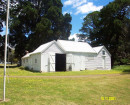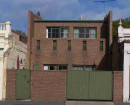INSITU HORSEWORKS
93 HARTS LANE KYNETON, MACEDON RANGES SHIRE
-
Add to tour
You must log in to do that.
-
Share
-
Shortlist place
You must log in to do that.
- Download report
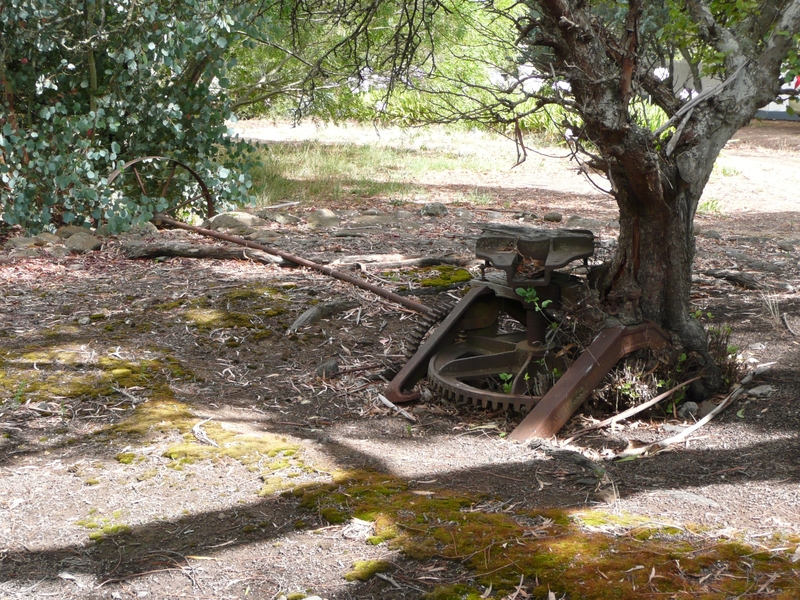

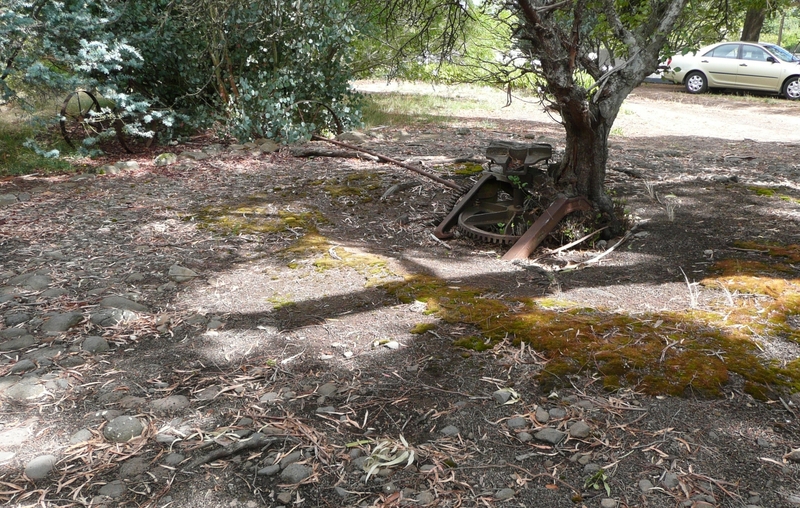
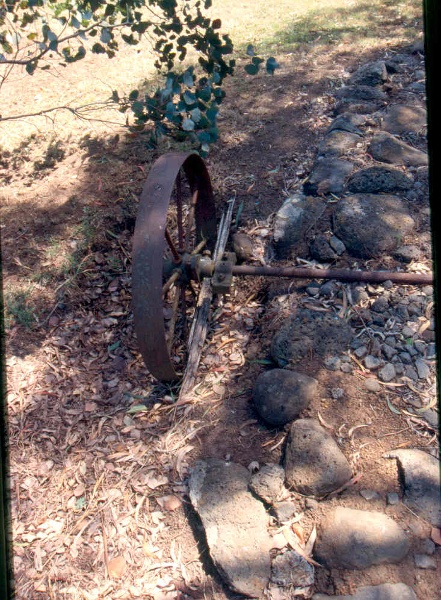




Statement of Significance
The Insitu Horseworks, Kyneton was a device which used horses to drive machinery. It consists of a cast iron and forged mechanism mounted on red gum sleepers and attached to a shaft which could be pulled by one or two horses walking round in a circle. The term “horseworks” referred to the machinery but includes the stone pitched platform on which the machine is installed. Horseworks were used extensively on Victorian farms from the 1850s to World War I. Before the use of the internal combustion engine, horseworks were the primary source of power to drive chaffcutters, winnowers and pumps, so were on every farm in the State The Insitu Horseworks, Kyneton is located on its original site close to a nineteenth century farmhouse. The horseworks was probably installed in or after 1904, when the manufacturer Cliff & Bunting commenced manufacture of these devices in Melbourne.
How is it significant?
The Insitu Horseworks, Kyneton is historically important to the State of Victoria.
Why is it significant?
The Insitu Horseworks Kyneton is historically significant in the history of farming and farming practices in Victoria as a rare example of a once-common farm machinery installation found on almost every farm in the State in the late nineteenth and early twentieth century. No other example has so far been located in Victoria. The Insitu Horseworks, Kyneton illustrates the importance of the horse to the practice of farming prior to World War I, and the use of horse-drawn machinery in farming in the nineteenth and early twentieth century.
The Insitu Horseworks, Kyneton is historically significant in demonstrating farming methods and machinery prior to the introduction of the internal combustion engine to Victorian farms. It is representative of a particular type of horse-drawn agricultural machinery used for chaff-cutting and other agricultural tasks.
-
-
INSITU HORSEWORKS - History
CONTEXTUAL HISTORY:
The chief source of power on Australian farms from the 1850s to the end of World War I was the draught horse. Teams of horses pulled farm implements and machinery from ploughs, cultivators and seed-drills to harvesters, as well as carting agricultural produce from the farm to the town or railway station. (Margaret and Phillip Simpson. Old Farm Machinery in Australia : a Fieldguide & Sourcebook. Kenthurst, NSW, Kangaroo Press, 1988, p. 93)Horse-powered stationary farm equipment drove machines such as winnowers. Horsepower was harnessed to these machines either by the endlessly revolving treadmill or the rotary horseworks.Prior to the use of steam for powering stationary machinery, horses were harnessed to a timber beam or arm which turned a vertical axle as the horse continually walked around in a circle. Though used for centuries in mining operations in the whim, the principle was transferred to farming operations when the capstan used in mining operations was replaced by a large toothed wheel to drive machinery. Such a wheel engaged with one or more smaller wheels which could be coupled to a train of wooden or cast-iron gears. A more modern and portable arrangement had a rotating arm and axle that could be moved and fixed to the ground. This was known as a horseworks (horse gear or horse sweep).
The smaller version of the horseworks was suitable for driving butter churns, pumps, maize shellers, small chaffcutters and other animal feed preparation machines. A larger horseworks powered by two horses was suitable for driving threshing machines, larger chaffcutters and winnowing machines.
In Australia horseworks were operated generally by horses or bullocks and the animals were forced to walk or trot in a circular path. The type of horse favoured for turning the gears was a quiet one with a slow and even pace and his eyes were covered by blinkers. (Simpson, pp. 93-4)
In 1895 there were 62 Victorian firms manufacturing agricultural implements and machinery. (Australian Ironmonger, 1 February 1897) In 1895 the agricultural machinery manufacturers Cliff and Bunting Pty Ltd acquired the North Melbourne premises of Swan and Co. (Leader, 1895) Cliff and Bunting had their factory in Blackwood Street, North Melbourne from 1904 and moved to Flemington Road, North Melbourne in 1918. They produced chaffcutters from 1901, horseworks and oil engines from 1904, and imported other kinds of agricultural machinery. They were acquired in 1955 by Baltic Simplex Machinery Co., which continued to produce agricultural implements and sold oil engines made by other companies. (Simpson, p. 129; Lesley Alves, Every Class of Implement of Machine: A History of T. Robinson & Co. and the Spotswood Factory: A Report for the Heritage Council. Melbourne, 1996 p.42)
HISTORY OF PLACE
The horseworks is on land which was first purchased by F. G. Dalgety in 1853 in partnership with Andrew Rose Cruikshank and Charles Ibbotson. Cruickshank was prominent in pastoral, political and financial circles, (unknown book on Elmore or Burnewang area?. P. 542) Bate describes him as an auctioneer, estate agent and wealthy squatter. (Weston Bate A History of Brighton, p. 329) Dalgety was the sole owner of the land by 1861.
In 1871, Dalgety sold to Henry Smith, a local stone mason, who retired to take up farming.
In 1904, Henry Smith died and his surviving son inherited the property. He continued to farm until his death in 1944. (Obituary, Kyneton Observer, 10 June 1944)
The homestead block of two and a half acres on which the horseworks stands was rented from 1920 to the Goudie family, who purchased the land in 1944 or 1954.
The property was purchased by the present owners in 1987.
It is not clear when the horseworks was installed, but it was probably during the ownership of Henry Smith's son. The installation could not be earlier than 1904, since Cliff and Bunting began local manufacture of horseworks in that year.
INSITU HORSEWORKS - Permit Exemptions
General Exemptions:General exemptions apply to all places and objects included in the Victorian Heritage Register (VHR). General exemptions have been designed to allow everyday activities, maintenance and changes to your property, which don’t harm its cultural heritage significance, to proceed without the need to obtain approvals under the Heritage Act 2017.Places of worship: In some circumstances, you can alter a place of worship to accommodate religious practices without a permit, but you must notify the Executive Director of Heritage Victoria before you start the works or activities at least 20 business days before the works or activities are to commence.Subdivision/consolidation: Permit exemptions exist for some subdivisions and consolidations. If the subdivision or consolidation is in accordance with a planning permit granted under Part 4 of the Planning and Environment Act 1987 and the application for the planning permit was referred to the Executive Director of Heritage Victoria as a determining referral authority, a permit is not required.Specific exemptions may also apply to your registered place or object. If applicable, these are listed below. Specific exemptions are tailored to the conservation and management needs of an individual registered place or object and set out works and activities that are exempt from the requirements of a permit. Specific exemptions prevail if they conflict with general exemptions. Find out more about heritage permit exemptions here.Specific Exemptions:General Conditions: 1. All exempted alterations are to be planned and carried out in a manner which prevents damage to the fabric of the registered place or object. General Conditions: 2. Should it become apparent during further inspection or the carrying out of alterations that original or previously hidden or inaccessible details of the place or object are revealed which relate to the significance of the place or object, then the exemption covering such alteration shall cease and the Executive Director shall be notified as soon as possible. General Conditions: 3. If there is a conservation policy and plan approved by the Executive Director, all works shall be in accordance with it. General Conditions: 4. Nothing in this declaration prevents the Executive Director from amending or rescinding all or any of the permit exemptions. General Conditions: 5. Nothing in this declaration exempts owners or their agents from the responsibility to seek relevant planning or building permits from the responsible authority where applicable. Landscape
*The process of gardening, mowing, removal of dead plants, disease and weed control, emergency and safety works.
*Management of trees in accordance with Australian Standard. Pruning of amenity trees AS 4373
*Repairs, conservation and maintenance of hard landscape elements.Machinery
*The regular application of fish oil to the unpainted metal parts.
INSITU HORSEWORKS - Permit Exemption Policy
It is the purpose of the permit exemptions to allow works that do not affect the cultural heritage significance of the Horseworks.
-
-
-
-
-
INSITU HORSEWORKS
 Victorian Heritage Register H1984
Victorian Heritage Register H1984 -
High Bank
 National Trust
National Trust
-
'Mororo' 13 Oxford Street, Malvern
 Stonnington City
Stonnington City -
1 Arnold Street
 Yarra City
Yarra City -
1 Austin Street
 Yarra City
Yarra City
-
-







